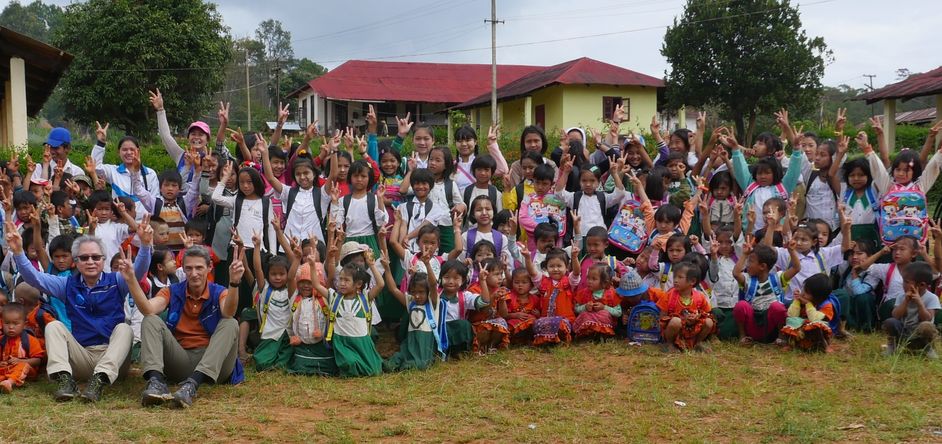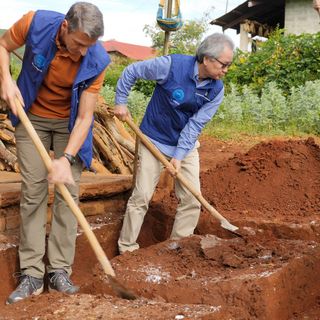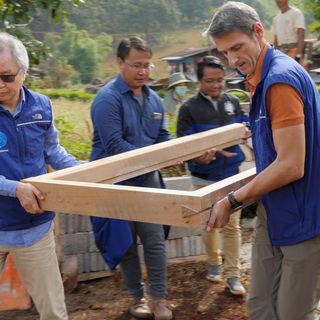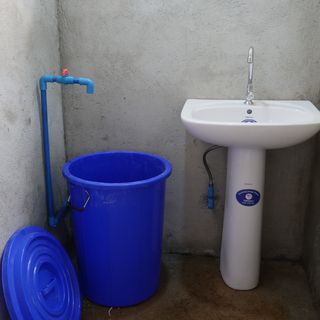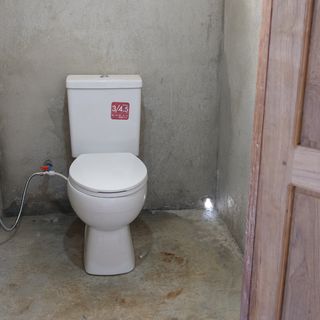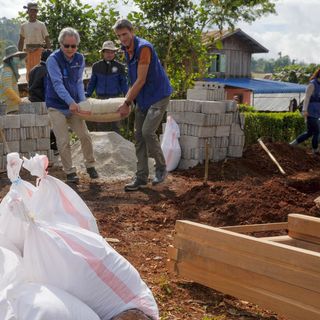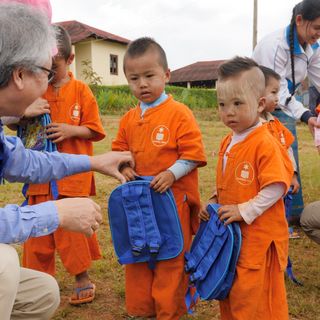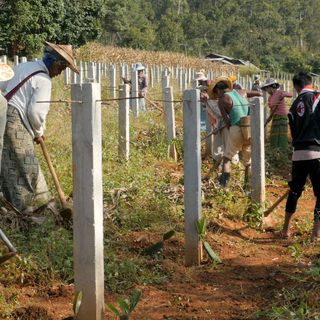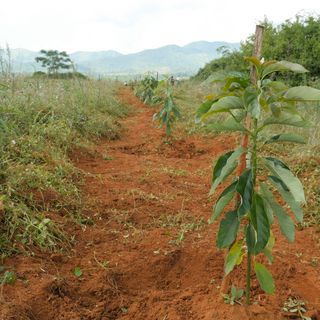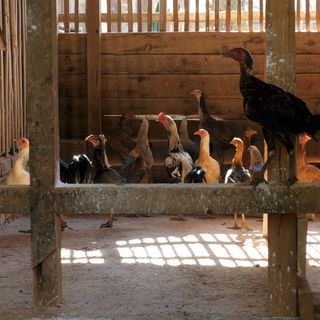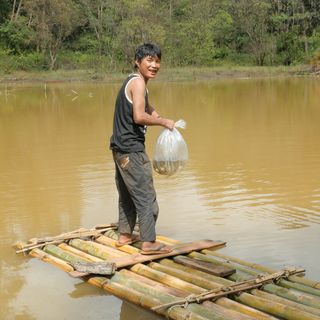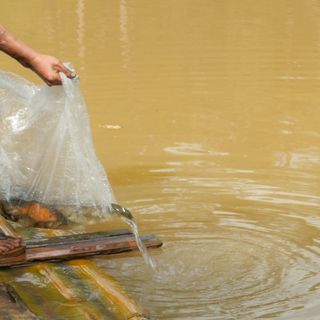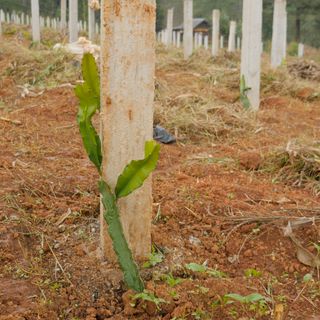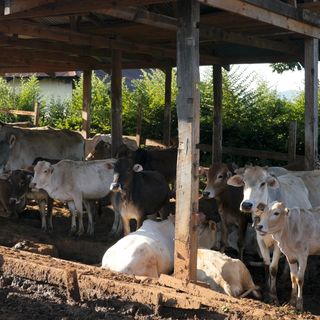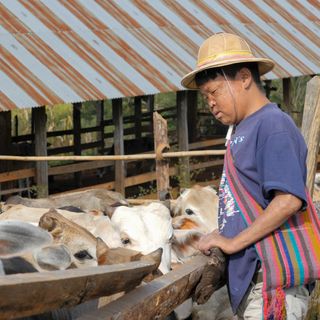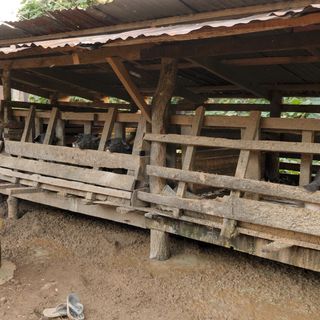2017: Travel and Project Report of the St. Lazarus-Fonds Europe
In 2015 a delegation from St. Lazarus-Fonds travelled to Myanmar to check the feasibility of proposed projects there, and then afterwards authorized the project financing. In December 2017 the chairman of the St. Lazarus-Fonds Europe, Peter Chung, and the vice-chairman, Dr. Thomas Gille, visited Loilem again.
Loilem (Myanmar), December 5 – 12, 2017
Visit and Project Report of the St. Lazarus-Fonds Europe
The St. Lazarus-Fonds Europe provides financial support to a colony of lepers and their families, in Myanmar, which used to be known as Burma. The St. Joseph leper colony is near the city of Loilem in Shan State in northeastern Myanmar.
In 2015 a delegation from St. Lazarus-Fonds travelled to Myanmar to check the feasibility of proposed projects there, and then afterwards authorized the project financing. In December 2017 the chairman of the St. Lazarus-Fonds Europe, Peter Chung, and the vice-chairman, Dr. Thomas Gille, visited Loilem again. The intention was to inspect the progress of the projects which the group is supporting and also to maintain a personal contact to the project workers on site. An additional and important goal for the travelers was to meet the ill and other occupants of the leper colony.
Travelling to Loilem is difficult and time-consuming. There are no direct flights from Europe to Myanmar, a stop-over is always necessary, such as in Singapore, Bangkok, or in the Arab region. In this case the trip was via Seoul/South Korea to the international airport at Yangon (once called Rangoon). The city of about 5 million inhabitants is by far the largest and most economically important city in the country. There the St. Lazarus board members met the documentary filmmaker Philip Staerke and his wife Julie, who comes from Burma. They now live in Myanmar, and support the St. Lazarus activities in many ways. After overnighting in Yangon the 4 travelers set off to the north the next day, with a roughly one and a half hour flight to the airport of Helo, a small airport which can only be reached with propeller machines. At Helo the group was met by Pater Paulu Nan. Since early 2017 he heads the local Caritas organization KMSS (Karuna Mission Social Solidarity), which oversees the projects in the leper colony in Loilem. He accompanied the group on the trip to Taunggyi, the capital of Shan State, where the KMSS has its office at the headquarters of the Archbishop of the Taunggyi diocese. From here the Caritas organization runs all its activities in the diocese.
Once the visitors arrived other KMSS employees were greeted. A particular mention should be made of Saw Han, who very professionally looks after all the work in the colony. Together with Pater Paulu’s whole team the St. Lazarus group discussed in detail the work carried out so far and the goals reached, as well as projects planned or proposed for the future. All of these things were to be viewed in the colony in the coming days.
This conversation made the necessity of some immediate measures apparent; so on the same afternoon the St. Lazarus-Fonds purchased 80 mattresses from a small shop in Taunggyi. The existing beds for the seriously ill lepers and other handicapped persons in Village Nr. 1 in the colony were described as very sparse, so assistance in the form of light mattresses was considered an urgent requirement.
196 backpacks, in various sizes and models to suit different ages, were purchased at a local wholesaler for the many local children who live with their families in the village. They will make it easier to transport school materials on the often difficult trip to and from the school.
In 2015 St. Lazarus members visited a small home for children who were infected with HIV, or had AIDS. At the time the request was for financial support for a new building to improve their wretched accommodations. In the meantime Caritas from Singapore has fulfilled this wish. Therefore Peter Chung and Thomas Gille were able to view the construction of the new children’s home.
The new building will enable the accommodation of up to 20 children in dignity and give them assistance. Prior to this it had only been possible to assist 5 children in very poor conditions in a much too small hut. Since the financing for the required furniture such as beds, tables and chairs was not yet secure, the two St. Lazarus-Fonds board members gave a commitment to provide support of 5000 USD. The nuns who look after the home were overjoyed. Prior to this the children had had to sleep on the floor in a dark cellar room. Now they will have real beds and normal rooms.
The next day the trip from Taunggyi to Loilem and the leper colony was started. This meant an almost four hour drive over very poor streets and through mountainous territory. The infrastructure in much of Myanmar, such as the standard and state of maintenance of the road network is a far cry from that found in the developed Asian countries or in Europe.
The St. Joseph leper colony was founded in 1938 by an Italian catholic priest about 5km outside of the small city of Loilem. Today it consists of 5 settlements spread over an extensive area, with about 800 inhabitants. Many have already been cured of leprosy, but currently there are about 150 who are ill with the disease. The village is led by a priest, Father Tacicio. He is supported by 4 nuns, who are mainly active in looking after children and the ill. Much of the daily work in the colony is organized and carried out by the inhabitants themselves.
Once in the village, the St. Lazarus chairman and vice chairman were able to get on with their real task – to inspect the success or lack thereof of the financially supported projects together with the employees of the KMSS, to film the process together with Philip Staerke, and to speak with the people from the village.
A group walk through the area was made to view two of the St. Lazarus funded projects. These were the well drilling project, started in 2015 and funded with USD 30,000, and the larger durable agriculture and animal husbandry project, funded with 80,000 USD. This second project consists of numerous smaller projects, and should lead to a lasting improvement in the ability of the inhabitants to provide their own food.
As part of a program to have the villages grow their own crops, plantations for dragon fruit, mangos and avocados were laid out. Chosen areas were accordingly prepared in 2015 and then planted. During the course of the work the following steps were taken according to the plan:
Ø Placement of 675 concrete posts (2.4 meters high) for climbing plants, and the planting of 1350 dragon fruit plants.
Ø In two areas excavation of holes for plants and the planting of 2000 avocado and mango seedlings. In accordance with the recommendations of local specialists these were alternately planted and the sensitive avocado plants were sheltered with very laboriously prepared roofs made of leaves and sticks.
These very extensive plantings greatly impressed the German visitors, particularly because they had seen the same land two years earlier, when it was more or less in the original state. Even the project manager appeared to be impressed with what had been achieved. At least three years will pass before the plants bear fruit, however, an important component of this project is its durability and long term nature.
In the animal projects three areas with visible success for the goal of improved supplies to the colony could be seen:
Ø New stalls to enable an expansion of the previously very limited pig breeding were constructed and 25 piglets were purchased. These developed splendidly, were able to be used directly as food and also to expand the breeding program.
Ø 50 cows were purchased with the funds provided and stalls were built for them. After initial difficulties there were soon positive developments and an expansion of the herd.
Ø A small chicken farm was also established. In addition to the production of eggs it has resulted in a supply of fresh meat for the colony.
The fish pond was in a much neglected state in 2015. Now it has been extensively restored through deepening, clearing out the mud, securing the shorelines and regulating the water depth by controlling the flows in and out. 20,000 fish were originally put into the pond and are showing good growth. The group was able to get a good impression of the quality of the fish when they were served freshly caught specimens. They were very good. The fish constitute a very important source of high quality food for the inhabitants of the colony, and for the future will be a lasting source of nutrition.
In conversations with Pater Paulu and the KMSS employees the pig farming and cows in particular were described as being economically particularly important, and can now, together with other project sectors, function independently. The inhabitants were very thankful for the improved supply situation and it gives them optimism for the future.
In addition to these investments the KMSS and external employees conducted training and educational programs on planting methods, creation of organic fertilizer, methods of fish farming, and also on the legal aspects of land usage and the principles of marketing produce.
The well projects which were approved at the time of the 2015 visit have now been completed. Three villages in the group now each have their own well and water tanks, and most have water taps close to the houses. In one village, however, three drill attempts did not find water, so that these attempts have had to be abandoned for now. There is another possibility: about 5km away a spring exits the earth, and this water could be piped to the village. The plans are well advanced, so that as soon as the financing is in place the work can begin. The group was able to look at the already completed wells, accompanied by members of the so-called water committees. These committees were formed in 2015 in each village in the colony. They enable the villagers to be involved from the start of the planning through the implementation of the construction, and then for the responsibility for the operation of the finished project. The visitors were shown the functioning wells and in conversations told of the enormous improvement in the water supply for the villagers.
After the successful start-up of the durable and lasting agriculture and cattle raising projects as well as the waterworks program a new project was started in 2017 with the KMSS: a program to improve health and environmental hygiene. The current problem is the inadequate sanitary situation, because for the villagers in the first village in particular (Hokhai Nr. 1) there are only squat latrines – these are simply holes in the floor of a wooden hut. Since many people in this village are seriously handicapped through leprosy, they have difficulty in getting to the latrines, which are some distance from the houses, and they have difficulty in using them. The latrines also do not have a water supply. In the rainy season the latrines are often flooded and unusable. The goal of this project is to install a toilet and shower house out of stone in each house in village Nr.1, to install sitting toilets and a water supply to enable flush toilets, a wash basin, and shower room. This last consists of a large water barrel with a scoop. In the first construction phase 30 such toilet houses can be built for the 80 villages.
During their two day visit in the leper colony St. Joseph Peter Chung and Thomas Gille were able to view the completed toilet houses. These are a huge improvement in the hygienic situation and make life much easier for the patients. To support the work in progress both visitors grabbed a shovel and took part in the excavation for the foundation or helped with the unloading of construction materials.
As in the agricultural programs this project is also accompanied by schooling for the villagers, in which the basics of hygiene and health improvements are discussed. The St. Lazarus visitors were able to briefly take part in such a course and were able to observe the lecture and the lively interaction with the participants.
Distributing the mattresses which had previously been purchased in Taunggyi to the patients and the school backpacks to the children was a particularly memorable event. The inhabitants were overjoyed to receive their new mattresses. Then the children lined up in order of age to take their sturdy, colourful, backpacks. About 100 children were present, while others were still in afternoon studies. Their faces reflected their joy over the backpacks, which make their difficult school day easier. The very young also came from their kindergarten, to take their first small backpack.
In connection with the improvement in the school situation and the support for children to obtain a better education and improve their future prospects, KMSS project manager Saw Han made an interesting proposal. He recommended the establishment of a small boarding school in the colony. After daily lessons are over, about 50 pupils of this school should have the opportunity to do homework, do further studies in a small bookshop, and also to stay overnight in this building. Presently it is not easy for many pupils to learn at home, because often after school hours the pupils must do household or family work. Girls in particular should profit from the boarding school – they often do not have equal opportunities in the Myanmar educational system. Since there already is a suitable building in the colony area, the chances of realizing this project look good, but first the building will need an extensive renovation. It was originally built as a boarding school, but then closed for financial reasons and has not been used in years. The running costs for taking care of the children and paying personal will be a significant factor.
The St. Lazarus-Fonds is presently looking for donations and supporters for this program of improving the school and educational situation, as well as for the sanitary and hygiene program.
After days of intensive experiences in the leper colony St. Joseph in Loilem/Myanmar the St. Lazarus board members Peter Chung and Dr. Thomas Gille returned to Germany, filled with many positive impressions of the current projects and full of ideas to improve the situation of the people in the colony.
Dr. Thomas Gille
